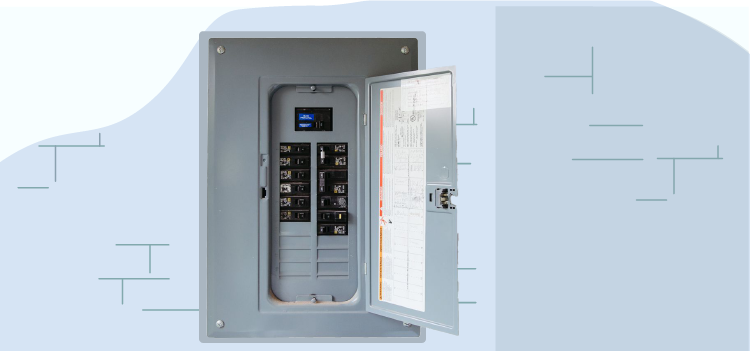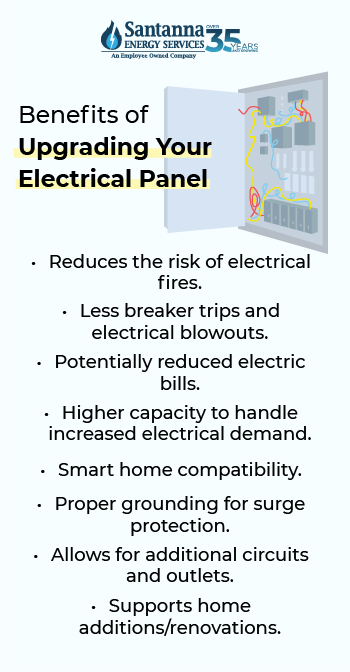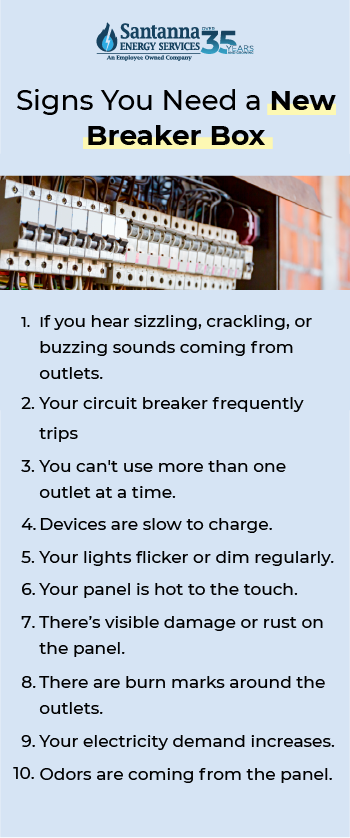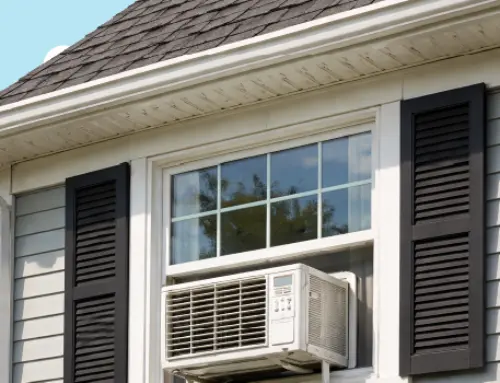Will Upgrading My Breaker Box Reduce My Electric Bill?
by Tyler Castle
13.4 min read

Tired of wondering if your breaker box is plotting against your bank account every time your energy bill arrives? Let’s flip the switch on this mystery and explore if upgrading your electrical panel could finally give you a break — and not just the kind that trips the breaker!
Outdated electrical panels can be a fire hazard or cause frequent breaker trips, making safety a top reason to upgrade. Upgrading can prevent electrical overloads that come from older systems unable to handle the demands of modern appliances. But can upgrading your breaker box reduce your electric bill? Read on for the answer!
Key Points of This Article:
- While a new breaker box doesn’t directly lower your electric bill, it can support energy-efficient appliances and renewable energy systems like solar panels, which may lead to long-term savings.
- The cost of upgrading an electrical panel typically ranges from $2,000 to $4,000, depending on factors like panel size, labor, permits, and location.
- Upgrading your breaker box can improve energy efficiency and safety, especially in older homes with outdated panels that may not meet modern electrical demands or safety standards.
- Signs that you may need an upgrade include frequent breaker trips, flickering lights, or a hot panel, and upgrading is especially important if you’re planning renovations, adding high-demand appliances, or installing EV chargers or solar systems.
What Is a Breaker Box (Electrical Panel) and What Does It Do?
Before we tell you if an upgraded breaker box can save you money, let’s break down what it can do for your home! A breaker box, also known as an electrical panel, is the main distribution center for your home’s electrical system.
A breaker box receives electricity from your utility company and distributes it across circuits to power lights, appliances, outlets, and devices. When someone tells you a “breaker is tripped,” in most cases, you’ll turn to the breaker box to restore your electricity.
Each circuit has a breaker that shuts off if it senses too much current, helping prevent fires or shocks. Modern homes typically need at least 100–200 amps to power energy-intensive devices like HVAC systems, washers, dryers, and EV chargers. If you’re adding more and more power to your home, an upgraded electrical box could help you. And a small or undersized panel might not be able to handle your increased energy consumption.
Will Upgrading My Breaker Box Reduce My Electric Bill?
Yes, upgrading your breaker box can potentially lead to reduced electric bills, but it’s not a direct cause-and-effect relationship.
A newer and more efficient breaker box can improve energy efficiency simply because newer models are made to handle more. When paired with energy-efficient appliances or renewable energy systems, like solar panels, it’s totally possible you can save money on your electric bill by upgrading your breaker box.
Upgrading your breaker box also promotes better protection against energy-wasting electrical faults and a newer or upgraded box requires lower maintenance, causing fewer electrical issues, leading to potentially reduced electric bills.
Typical Cost of an Electrical Panel Upgrade
The typical cost of upgrading your electrical panel costs anywhere from $2,000 – $4,000. This process usually includes the panel itself, labor charges, and any rewiring that’s necessary.
An electrical panel, also called a breaker box, is the central hub of electricity distribution in your home. It controls the electrical circuits and protects your home from electrical overload. The typical cost of an electrical panel upgrade will vary based on a few factors. These factors include:
Panel Size and Amperage: The typical cost of an electrical panel upgrade will depend on the size and capacity of the panel you need. For example, upgrading from a 100-amp panel to a 200-amp panel is more expensive.
Labor Costs: Labor rates can vary significantly by region. Electricians typically charge between $250 and $350 per hour.
Permits and Inspections: Many jurisdictions require permits and inspections for electrical work, which can add a few hundred dollars to the total cost.
Type of Panel: The brand and quality of the electrical panel can also affect the price. High-end panels or those with specialized features, like surge protection, can be more costly.
Panel Location: If you’re opting for a bigger electrical panel, relocating your panel might be needed if your old panel is in a hard-to-reach space. This can drive up the cost of your electrical panel upgrade.
Key Reasons to Upgrade Your Electrical Panel

The benefits of upgrading your electrical panel go beyond reducing your electric bills. If you’re wondering if you really need to upgrade your panel, here are a couple of the most compelling reasons:
Safety
Old electrical panels, especially those over 20-30 years old, may not comply with modern safety standards and can overheat, increasing the risk of fire. Upgrading your breaker box can significantly reduce the risk of electrical fires by ensuring proper functionality and circuit protection in modern appliances.
Outdated panels often struggle to manage today’s energy demands, leading to frequent breaker trips or fuse blowouts leading to safety risks. An upgraded panel ensures that your electrical system can safely handle the increased load, reducing the likelihood of overloading circuits.
Capacity
Many older homes were commonly built with 60-100 amp panels, which are inadequate for modern lifestyles that include high-demand appliances like HVAC systems and more appliances. Upgrading to a higher panel that can accommodate home expansions, new appliances, or energy-efficient systems can allow for future upgrades.
A modern electrical panel helps your home handle your family’s energy use without straining or reducing performance.
Upgrading your electrical box is especially important to EV owners. As electric vehicles (EVs) become more common, homes need upgraded panels to support dedicated EV charging stations, which can require more power than an older breaker box can handle. Upgrading the electrical panel ensures there is sufficient capacity for EV charging while supporting other household electrical demands.
Efficiency
If you’re looking to install solar panels or other renewable energy sources like wind turbines, your electrical panel needs to be upgraded to integrate these systems. A new panel can help with the seamless flow of energy, ensuring efficiency in handling the energy generated by renewables and preventing power wastage.
In the same way, upgrading to a new breaker box can increase the energy efficiency of your home as a whole, and with increased efficiency, this can lead to a lower electric bill.
Smart Home Compatibility
New panels are better suited to accommodate smart home devices and energy-efficient technologies, allowing for optimized electricity usage throughout the home. These systems work together to manage power more efficiently, potentially leading to reduced energy bills.
Pros and Cons of Upgrading Your Electrical Panel
Unsure if an electrical panel upgrade is right for you? As energy experts with 35 years of experience, we’ve got the ultimate pros and cons list. Here’s what you need to know about upgrading your electrical panel:
Pros of Upgrading Your Electrical Panel:
- Increases electrical capacity: Running more appliances than usual? Have you recently upgraded to power hungry appliances? No worries! With an upgraded panel, you’ll be able to handle spikes in energy usage or increases in appliance use.
- It future-proofs your home for EVs, solar, and new tech: With an upgraded panel, you can add new features that require electricity charging.
- Reduces risk of fire or malfunction: Old or overloaded panels can overheat, trip breakers, or fail completely, sometimes causing dangerous electrical fires. Upgrading to a modern panel ensures proper circuit distribution and up-to-date safety features.
- May increase home resale value: A newer panel signals to buyers that your home’s electrical system is safe, efficient, and ready for modern demands, which can be a selling point.
- Allows safer home renovations and appliance installs: Whether you’re adding a new HVAC system, finishing a basement, or upgrading your kitchen, an upgraded panel ensures the wiring and circuits can safely handle the extra load.
Cons of Upgrading Your Electrical Panel:
- High upfront cost: Upgrading an electrical panel can be a significant investment, often costing several thousand dollars depending on your home’s needs.
- Requires power shutoff during installation: Your home will be without electricity for several hours, sometimes longer, while the panel is being replaced. This can be inconvenient if you work from home or rely on powered devices.
- Permits and inspections may delay the timeline: Electrical panel upgrades typically require permits and inspections from your local municipality.
- Not guaranteed to reduce energy bills significantly: While a new panel improves capacity and safety, it doesn’t directly lower your energy consumption.
Why an Upgraded Panel Prepares Your Home for the Future
According to the Rocky Mountain Institute, nearly 60% of new homes being built nationwide are all-electric. This shows that electrification is on the rise, with homes shifting away from gas to electric. With this growing demand for electricity, an upgraded electrical box can ensure you have enough power and space to meet demand.
Similarly, if you’re interested in EV chargers or solar panels, that tech requires a modern and high-capacity electrical panel. In the same way, energy-efficient homes are more desirable and valuable. This can add to your home value in the long run if you’re eventually looking to sell.
Lastly, while you may not “need” 200 amps today, you probably will in 5–10 years as the demand for electricity grows, and so will the grid.
Signs You Might Need to Upgrade Your Breaker Box 
While electrical panels typically last several decades, certain signs indicate that an upgrade may be necessary to meet your home’s electrical demands. It’s especially important to consider an upgrade in your breaker box if you’re planning a renovation or adding new appliances, knowing the signs to upgrade can prevent future problems or unexpected costs.
Here are some of the most common signs you might need an upgraded breaker box:
- If you hear sizzling, crackling, or buzzing sounds coming from outlets.
- Your circuit breaker frequently trips
- You can’t use more than one appliance at a time without an appliance being unplugged.
- Devices are slow to charge.
- Your lights flicker or dim regularly.
- Your panel is hot to the touch.
- There’s visible damage or rust on the panel.
- There are burn marks around the outlets.
- Your electricity demand increases.
- Odors are coming from the panel.
Do I Need a Permit To Upgrade My Electrical Panel?
Yes, you typically need a permit to upgrade your electrical box in residential homes. Most local building codes require permits for electrical work to ensure that it meets safety standards and regulations.
Obtaining a permit allows for an inspection of the work done, which can help prevent hazards related to improper installations. It’s important to check with your local building department or consult a licensed electrician to understand the specific requirements for your area.
A permit is required even if you’re considering replacing your electrical panel. Don’t attempt to replace your panel yourself; doing so can lead to electrical shock and prolonged electrical problems in your home without professional installation.
How Much Does It Cost To Replace an Electrical Panel?
Replacing an electrical panel on average can cost anywhere from $550 to $3,000, but most homeowners pay around $1,300.
How much you’ll pay for an electrical panel replacement will depend on your model, labor needed, and any rewiring. Keep in mind that a simple replacement will cost less than a full panel upgrade because it typically involves swapping out the existing panel with a similar model without making significant changes to the electrical system.
Since there’s no need to increase the amperage or reconfigure the circuits, the labor is usually less, and a replacement doesn’t require extensive rewiring which drives down the cost. If you want to upgrade your panel to meet higher electricity demands in your home, it will come at a higher cost.
How To Upgrade Your Electrical Panel
Upgrading your electrical panel entails replacing an older, lower-capacity panel with a newer one that supports modern and better electrical demands. Older panels were often designed to handle significantly lower electrical loads than today’s households require, so upgrading ensures your home can safely power new appliances and technologies.
We strongly recommend you don’t attempt to upgrade your electrical panel on your own as this can lead to injury and improper installation if you’re not a professional. Generally, here is how the process of upgrading your electrical panel goes:
- Assessing your home’s electrical needs: After you’ve hired an electrician, your hire professional assesses your home and helps you determine the right panel size based on how much electricity your home uses.
- Power Shut Off: Before starting the upgrade, your electrician will coordinate with the utility company to temporarily shut off power to your home.
- Remove the Old Panel: The existing panel is carefully disconnected and removed. If the new panel will be installed in a different location, some additional rewiring may be necessary.
- Installing a new panel: A larger, more modern panel is installed. This includes updated circuit breakers, better grounding, and new safety features. After installation, your electrician will test your panel to ensure everything is working correctly.
- Inspection and Power Restoration: Once the new panel is in place, an inspector will verify that the installation meets safety standards.
Tax Credits, Incentives, and Rebates for Upgrading Your Breaker Box
If you upgrade your electrical panel, you may be eligible for a federal tax credit of up to $3,200 through EnergyStar. This credit applies to qualifying equipment purchased and installed between January 1, 2023, and December 31, 2032.
To qualify, the work must follow National Electric Code standards and generally involve a panel with a capacity of 200 amps or more. In addition, the credit also applies when the upgrade supports certain energy-efficient systems such as heat pump water heaters, heat pumps, central air conditioners, furnaces, hot water boilers, or biomass stoves and boilers.
How Do I Hide an Electrical Box?

Although electrical boxes are essential to every home for power, let’s be honest, they are not the prettiest sight to see. If you’re limited on space in your home, you don’t want the eyesore of an upgraded electrical box to throw off the look of your home. Here are some of the most clever ways you can hide your electrical box:
- Furniture Placement: Position furniture such as sofas, bookshelves, or cabinets to conceal the electrical box without blocking access.
- Decorative Cover: Use a decorative cover or box that can blend in with your decor. These can be found at home improvement stores and are designed to mask electrical boxes while allowing for ventilation and access.
- Wall Art or Shelving: Install wall art, shelves, or framed pictures that can cover the box while still being accessible.
- Custom Cabinetry: Build a custom cabinet or enclosure around the electrical box. Ensure it has doors or a removable panel for easy access.
- Wall Treatments: Paint the box the same color as the wall or apply wallpaper to make it less noticeable, provided it doesn’t obstruct access.
- Plant Arrangement: If the electrical box is located outdoors or in a garden area, you can use decorative plants or trellises to partially hide it.
Ultimately, upgrading your electrical panel isn’t just about ensuring your home meets modern safety standards; it also enhances efficiency, accommodates future energy needs, and may even result in lower energy costs.
For homeowners who value stability, Santanna Energy Services offers the Unlimited Energy plan, where the supply portion of your bill stays the same every month, no matter how much electricity you use.** By pairing a modern electrical panel with an energy plan built around consistency, you can enjoy a home that’s not only prepared for future demands but also easier to plan and budget for.
** Restrictions apply. Enrollment based upon program eligibility. Customers using more than 125% of normal monthly usage as determined by Santanna may be required to switch plans.
** Restrictions apply. Enrollment based upon program eligibility. Customers using more than 125% of normal monthly usage as determined by Santanna may be required to switch plans.
Tyler is an experienced energy professional, having worked for Santanna Energy Services, for the past four years. He is passionate about renewable energy and believes that diversifying the energy grid is the key to a sustainable future. Tyler is dedicated to supplying consumers with the best possible energy solutions and works diligently to make sure that Santanna can deliver the highest quality service.







